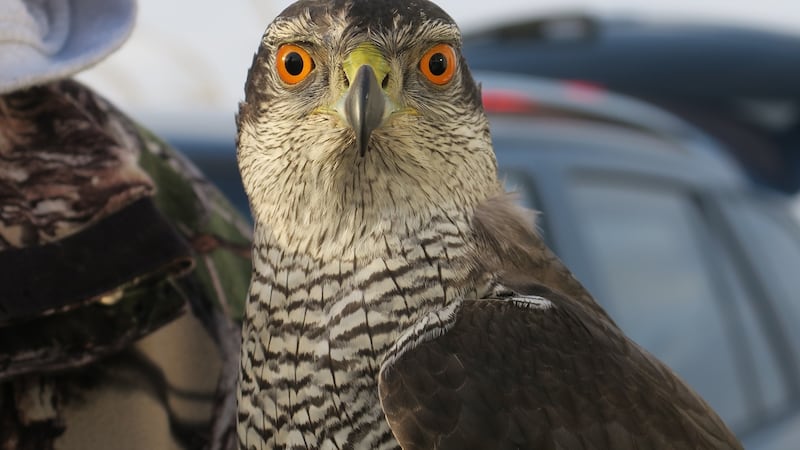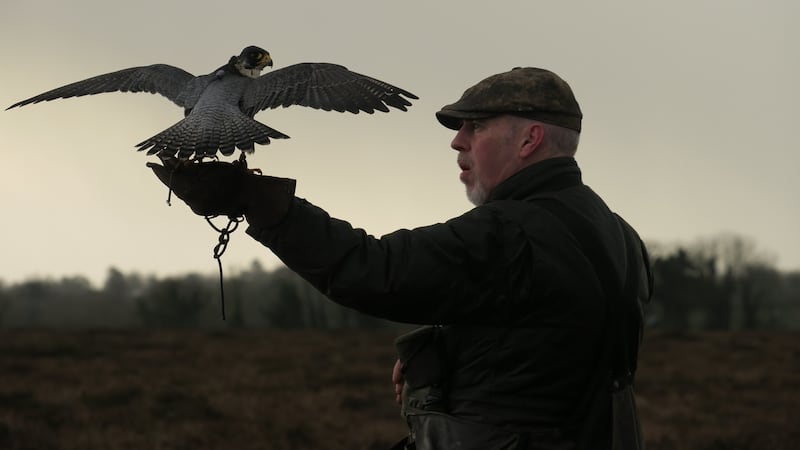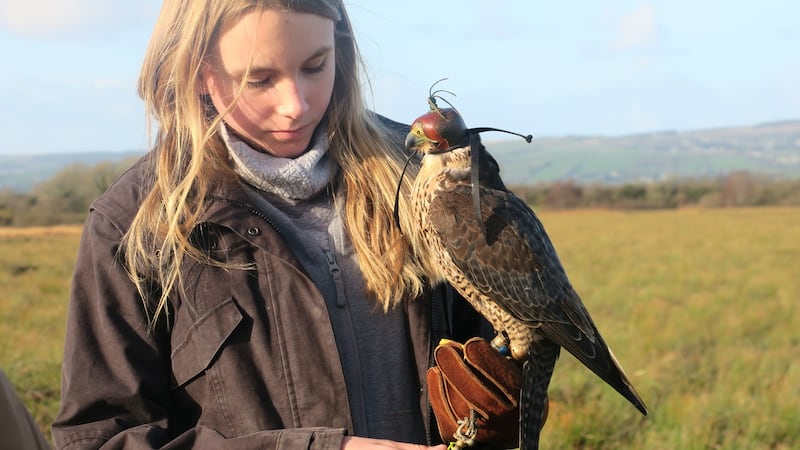As our two cars breast a steep slope, the silhouette of a big bird of prey appears abruptly. It is perched on the ground just over the rapidly approaching horizon, so that only its head and upper body can be seen, making it look oddly enlarged. A split second later it takes flight, briefly revealing itself as a buzzard, and slides away out of view.
And then we are out on the crest of the ridge, where familiar Wicklow landmarks – the two Sugarloafs, Bray Head, and the coastline beyond Greystones – offer unfamiliar and breath-taking perspectives, giving an impression of vast open spaces untypical of this part of this county. It’s an ideal landscape for training a falcon.
Almost immediately, another bird of prey is in attendance, making low, rapid passes close to the car in front. This is a peregrine. Unlike the heavy, broad-winged buzzard, falcons are all sharp and streamlined angles, built for speed. A peregrine ‘stooping’ (diving) on its prey can reach speeds close to 400 km/h, arguably the fastest creature on earth. From ancient Egyptian mythology to the poems of WB Yeats, it is an icon of cold, ferocious wildness.

Yet when Maurice Nicholson steps out of his car, and swings a lure from a heavily gloved hand, the falcon catches it, brings it to the ground, and then comes up to Nicholson’s wrist, almost as if it belonged there. It submits easily to the imposition of an elegant soft leather hood that completely obscures its vision. To use one of many terms that the English language has borrowed from falconry, often via Shakespeare, it has been hoodwinked.
Which is not necessarily to say that it has been fooled. This young tiercel (male) was taken as a chick from its nest earlier this year by Nicholson, under licence from the National Parks and Wildlife Service. It has learned to associate him with food, and is soon sitting, loosely tethered to a portable perch, fiercely consuming a morsel of pigeon meat off the bone.
Butchery is among the "vast array of skills" that Emma Ford requires of would-be falconers in her classic textbook on the art and practice of the sport. It is not an activity to be taken up lightly. A bird of prey is not a pet, and demands intense commitment (and lots of time) from its owner, as anyone who reads Helen McDonald's brilliant – and heart-breaking – recent memoir, H is for Hawk, will realise. (Confusingly, traditional falconers often use the terms "hawk" and "falcon" almost interchangeably, though they are distinct categories of birds of prey, with very different hunting techniques).
The training phase of falconry is particularly demanding, and Nicholson has chosen an adventurous method known as “tame hacking”.
The young bird is released every morning, and flies free during the day. It may attempt to take prey, but is unlikely to be skilled enough to do so without parents to imitate. In any case, it knows that its surrogate parent will return with food in the evening.

Hacking used to be a risky business, as some birds do learn to fend for themselves and go missing. So Nicholson’s bird carries a GPS transmitter on its back, and a radio on its leg. He can track it on his smartphone.
Next, Nicholson prepares a bright yellow kite, an unlikely but useful prop for training. Another pigeon morsel is attached, far up on the kite line, by an ingenious device. The breeze sends the kite up high, and holds it steady. Unhooded and untethered, the peregrine takes off after it, climbing very fast and almost vertically.
“I like that in a bird,” says Nicholson’s colleague Hilary Adam White, “it shows it has plenty of energy, and is eager for prey.”
White is the editor of the International Association of Falconry's online newsletter, is very active in the Irish Hawking Club, and has hunted with sparrow hawks since he was 12.

As the peregrine seizes the meat, a spring is released that sends the morsel, still attached, sliding down the line, with the falcon clinging to it, all the way to the ground. It brings it back to Nicholson’s glove. Nicholson then lets the falcon fly off with its dinner. It feeds on the ground close by, hidden by a hump in the field. Nicholson approaches it as it is finishing eating.
The “etiquette” is very important here. He must crouch low, almost crawling, and come towards it from the front; otherwise the bird may see him as a threat and take off. “You do not,” says White, “want your hawk up in a tree with its belly full when it’s getting dark.”
Soon it is hooded again, and sitting quietly in the back of Nicholson’s car. Its mobile perch is called a cadge, so it is literally “cadging” a lift to its enclosed ‘mews’, two more terms we have borrowed from the sport, where it will spend the night.
For information on falconry in Ireland, visit the Irish Hawking Club.
Falconry as a force for conservation?
As the falconry hunting season opens in September, Nicholson will take his bird out to seek its own prey, ranging from snipe to woodpigeon. But he and White agree that a large ‘bag’, often a criterion of success in shooting and fishing, plays little part in their assessment of a good day’s falconry.
“With a falcon, you mostly come back with no prey taken, and that’s no problem,” says Nicholson. And if his bird does take prey, he lets it eat it all. This is a departure from both the long aristocratic falconry tradition, and the equally ancient practice, once common here, where poor families kept a hawk to put food on the table.
“The invention of the shotgun almost destroyed falconry in Europe and north America,” says White. “It has been revived here as a hobby, and also as a profession, where falconers control urban pests like feral pigeons, or keep runways clear in airports.” He also distinguishes active falconry from bird-of-prey display centres, though he agrees these can be educational.
“I see falconry mainly as an exceptional kind of interaction with nature. I don’t want to look at the natural world through a pane of glass. I want to be in there, getting my hands dirty. Falconry is a unique way of participating in how predator and prey relate to each other in the field. Often, when a hawk misses a kill, you will hear falconers comment enthusiastically, not on ‘failure’, but on how amazingly well the prey evaded the hawk.”
His comments echo the words of the great British conservationist, Sir Peter Scott, who eventually gave up shooting himself, but commented ruefully that no-one understands the behaviour and flight patterns of wildfowl quite like a hunter does.
Perhaps surprisingly, White argues that falconry is a positive force for the environment. Anyone ethically opposed to all blood-sports will obviously challenge this view. But White can point to major environmental endorsements for the sport, including one from the International Union for the Conservation of Nature, and to the involvement of Irish Hawking Club members in both national conservation campaigns and the rehabilitation of injured birds of prey.
“We have three interests that commit us to conservation,” he says. “The health of wild populations of birds of prey. The health of the species they hunt. And the health of the habitats that sustain both.”











